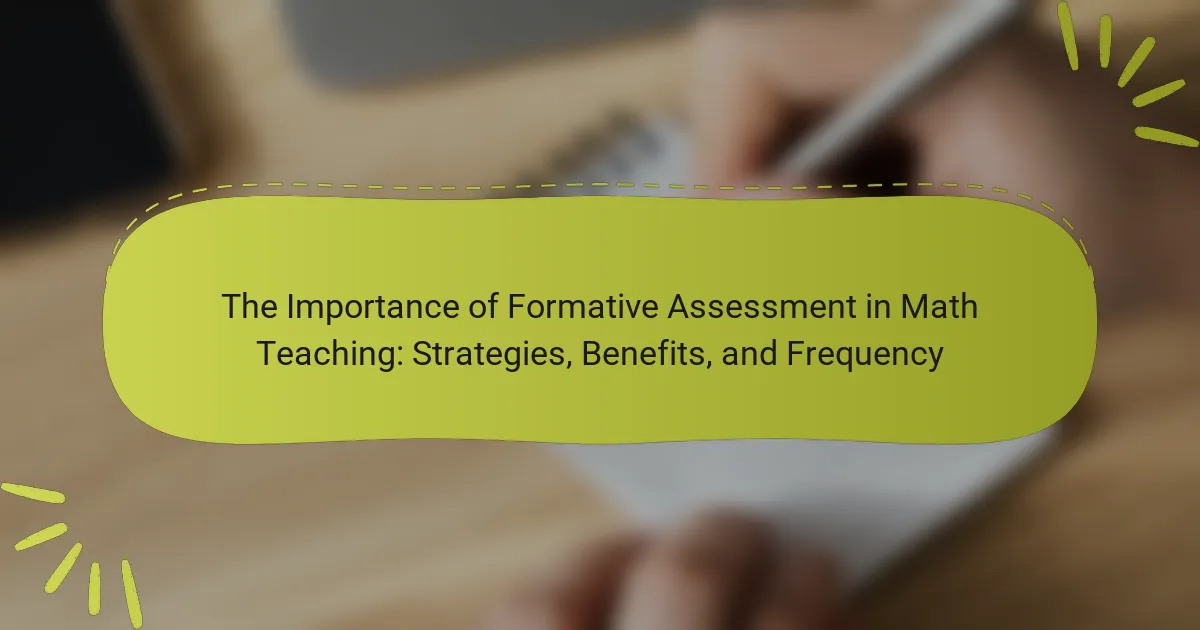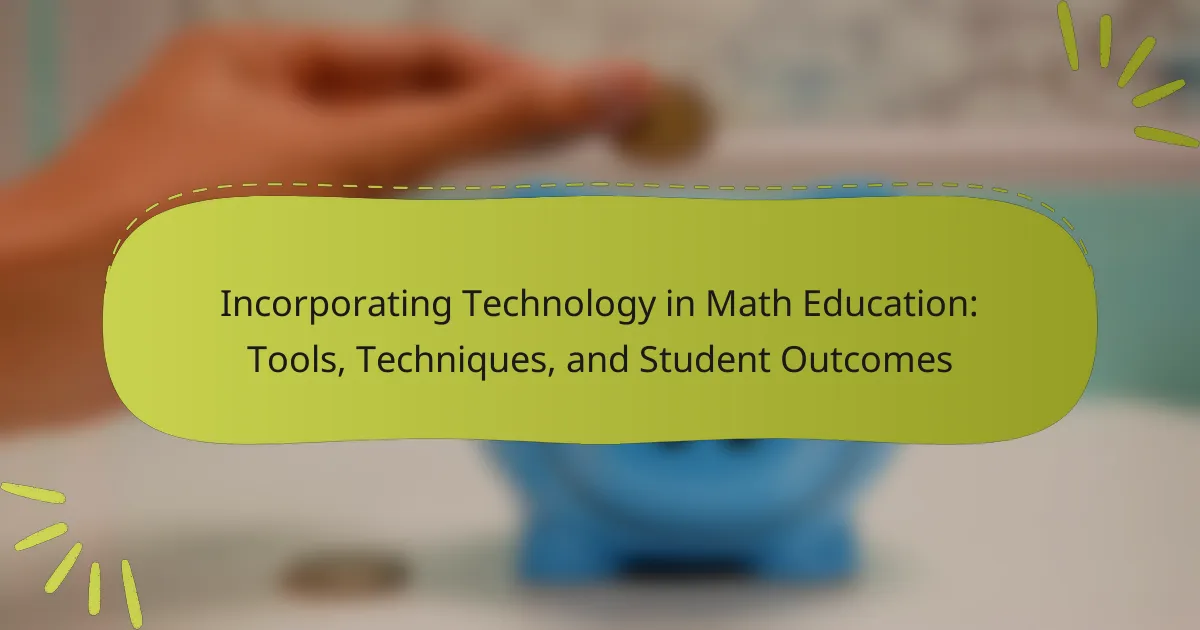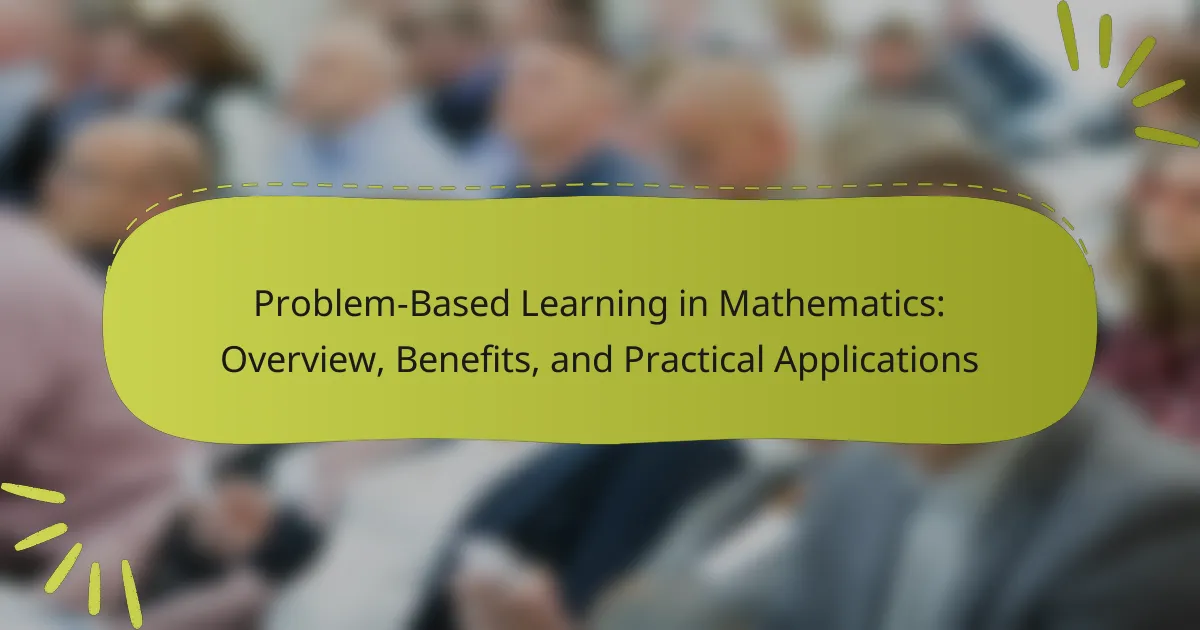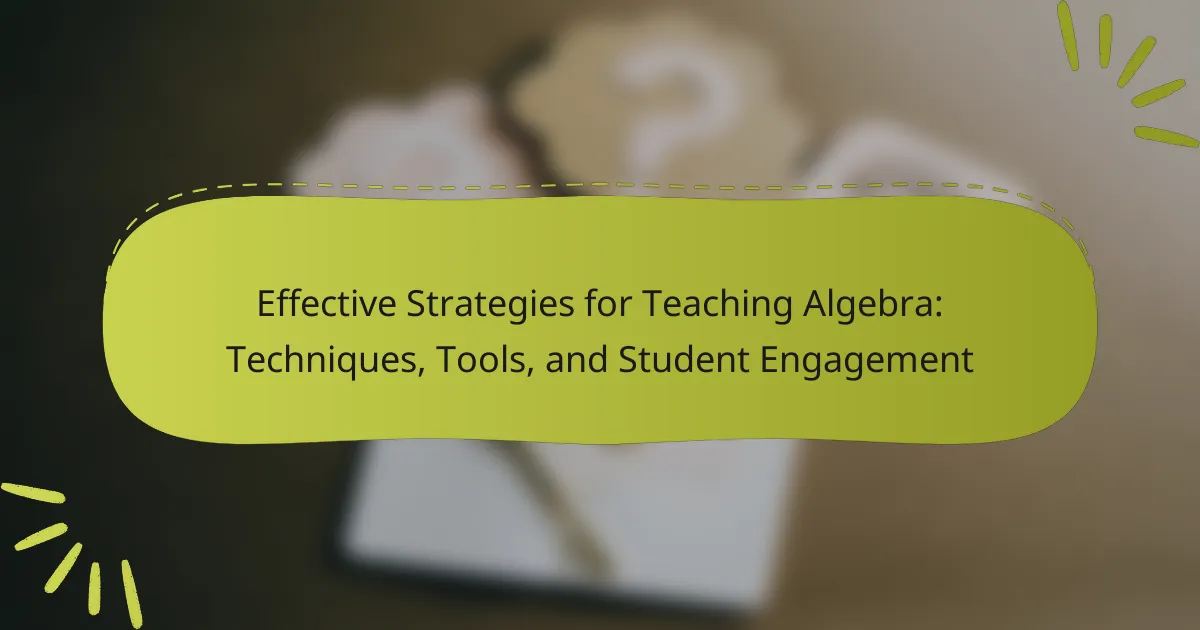Collaborative learning in math is an educational strategy where students engage in teamwork to solve mathematical problems, enhancing their understanding through peer interaction. This approach promotes discussions, strategy sharing, and constructive feedback, leading to improved problem-solving skills and higher academic performance. Research indicates that collaborative learning fosters a sense of community and accountability, while also encouraging social skills and a growth mindset. Assessment techniques such as peer assessment, formative assessments, and group presentations further support this learning method, enhancing student engagement and comprehension in mathematics.
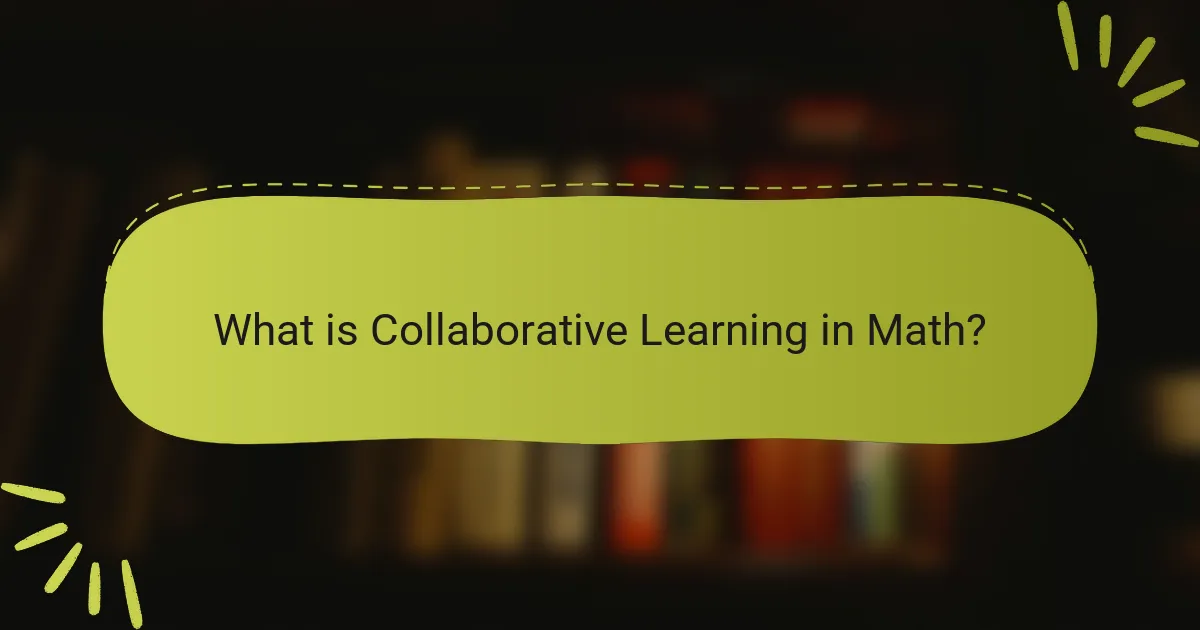
What is Collaborative Learning in Math?
Collaborative learning in math is an educational approach where students work together to solve mathematical problems. This method encourages peer interaction and shared understanding of concepts. Students engage in discussions, share strategies, and provide feedback to one another. Research shows that collaborative learning can enhance problem-solving skills and deepen comprehension. It fosters a sense of community and accountability among learners. Studies indicate that students participating in collaborative learning often achieve higher academic performance. This approach aligns with constructivist theories of learning, emphasizing active participation and social interaction.
How is Collaborative Learning defined in the context of mathematics?
Collaborative learning in mathematics is defined as an educational approach where students work together to solve mathematical problems. This method encourages interaction and communication among peers. It fosters a deeper understanding of mathematical concepts through discussion and shared reasoning. Research indicates that collaborative learning can enhance problem-solving skills and critical thinking. A study by Johnson and Johnson (2009) highlights that students engaged in collaborative learning demonstrate improved academic performance in mathematics. This approach not only builds mathematical skills but also promotes teamwork and social skills among learners.
What are the key characteristics of Collaborative Learning in Math?
Collaborative learning in math is characterized by shared goals, active participation, and peer interaction. Students work together to solve problems and deepen their understanding. This approach fosters critical thinking and enhances communication skills. Group discussions and activities allow for diverse perspectives. Collaborative learning also promotes accountability among peers. Research shows that students engaged in collaborative learning perform better academically. A study by Johnson and Johnson (2009) highlights improved problem-solving abilities in collaborative settings.
How does Collaborative Learning differ from traditional learning methods?
Collaborative Learning emphasizes group work and peer interaction, while traditional learning methods focus on individual instruction and teacher-led lectures. In Collaborative Learning, students engage in discussions, share ideas, and solve problems together. This approach fosters critical thinking and enhances communication skills. Traditional methods often rely on rote memorization and passive learning, limiting student interaction. Research indicates that Collaborative Learning can lead to higher retention rates and improved academic performance. A study by Johnson and Johnson (1999) found that students in collaborative settings performed better than those in traditional classrooms.
Why is Collaborative Learning important in math education?
Collaborative learning is important in math education because it enhances student understanding and problem-solving skills. This approach encourages students to engage actively with their peers. Through discussion and teamwork, students can share diverse perspectives. Collaborative learning fosters critical thinking, as students must articulate their reasoning. It also promotes communication skills, essential in both academic and real-world contexts. Research shows that students involved in collaborative learning perform better on assessments. A study by Johnson and Johnson (1999) found that cooperative learning strategies lead to higher achievement in mathematics. This evidence supports the effectiveness of collaborative learning in improving math education outcomes.
What impact does Collaborative Learning have on student engagement?
Collaborative learning significantly enhances student engagement. It fosters active participation among students. When students work together, they share ideas and resources. This interaction creates a sense of community. Research shows that collaborative learning can increase motivation and interest in the subject matter. According to a study by Johnson and Johnson (2009), students in collaborative environments demonstrate higher levels of engagement. They are more likely to contribute to discussions and stay focused on tasks. Collaborative learning also promotes accountability among peers. Each student feels responsible for their contribution, leading to deeper involvement in the learning process.
How does Collaborative Learning influence mathematical understanding?
Collaborative learning enhances mathematical understanding by promoting active engagement among students. It allows learners to discuss and solve problems collectively. This interaction fosters deeper comprehension of mathematical concepts. Research shows that students involved in collaborative learning perform better in mathematics. For instance, a study by Johnson and Johnson (1999) found that cooperative learning strategies lead to higher achievement and retention of mathematical knowledge. Collaborative settings also encourage diverse perspectives, which can clarify misunderstandings. This approach helps students develop critical thinking and problem-solving skills essential for mathematics. Overall, collaborative learning significantly contributes to improved mathematical understanding through interaction and shared knowledge.
What methods are commonly used in Collaborative Learning for math?
Common methods used in Collaborative Learning for math include group work, peer teaching, and problem-based learning. Group work encourages students to solve mathematical problems together. This method fosters communication and teamwork skills. Peer teaching allows students to explain concepts to one another. It reinforces their understanding and builds confidence. Problem-based learning engages students in real-world scenarios. This approach enhances critical thinking and application of mathematical concepts. Research shows that these methods improve student achievement in mathematics. A study by Johnson and Johnson (1999) indicates that collaborative learning leads to higher academic performance.
What are the different approaches to implementing Collaborative Learning in math classes?
Different approaches to implementing Collaborative Learning in math classes include group work, peer teaching, and project-based learning. Group work allows students to solve problems together, fostering discussion and diverse perspectives. Peer teaching involves students explaining concepts to each other, enhancing understanding through teaching. Project-based learning engages students in real-world problems, promoting teamwork and critical thinking. Research shows that these methods improve student engagement and achievement in mathematics. For instance, a study by Johnson and Johnson (1999) found that cooperative learning enhances academic performance and social skills.
How can technology facilitate Collaborative Learning in mathematics?
Technology facilitates collaborative learning in mathematics by providing interactive platforms for students to engage with each other. Online tools like discussion forums and collaborative software enable real-time communication. These platforms support group problem-solving and peer feedback, enhancing understanding. Virtual classrooms allow for shared resources and collective exploration of mathematical concepts. Additionally, technology offers access to diverse educational materials, fostering varied learning styles. Tools such as interactive whiteboards can visualize complex problems collaboratively. Research shows that technology integration in education improves student engagement and achievement. For instance, a study by the U.S. Department of Education found that technology use in classrooms leads to higher student performance in mathematics.
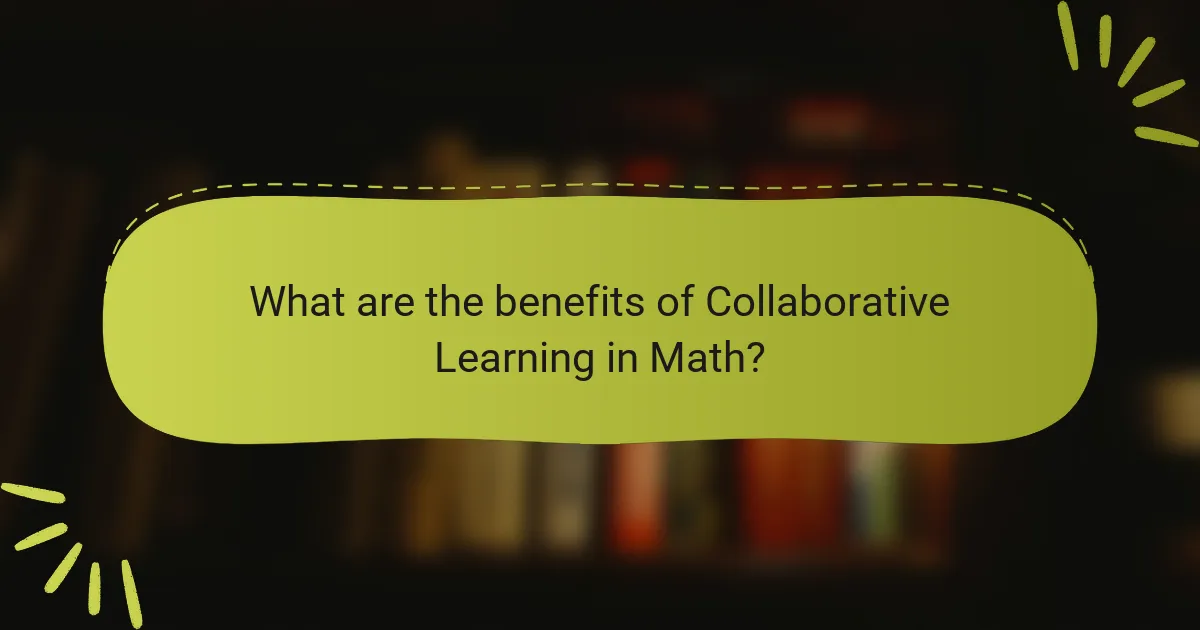
What are the benefits of Collaborative Learning in Math?
Collaborative learning in math enhances student engagement and improves problem-solving skills. It fosters a deeper understanding of mathematical concepts through peer interaction. Students often explain their reasoning to each other, which reinforces their own learning. Research shows that collaborative learning can lead to higher academic achievement. A study by Johnson and Johnson (1999) found that students in collaborative settings performed better on tests compared to those who learned individually. Additionally, it promotes social skills and teamwork, crucial for success in real-world scenarios. Collaborative learning also encourages a growth mindset, as students learn from their mistakes in a supportive environment.
How does Collaborative Learning enhance problem-solving skills?
Collaborative learning enhances problem-solving skills by fostering teamwork and communication among participants. This approach encourages students to share diverse perspectives on problems. It allows learners to engage in discussions that promote critical thinking. Research indicates that collaboration leads to deeper understanding and retention of concepts. A study by Johnson and Johnson (2014) found that students in collaborative settings performed better in problem-solving tasks than those working individually. Collaboration also helps develop social skills necessary for effective teamwork. By working together, students learn to negotiate and compromise, which are vital in solving complex problems.
What role does peer interaction play in developing these skills?
Peer interaction is crucial in developing collaborative learning skills. It enhances communication abilities among students. Engaging with peers fosters problem-solving skills through shared perspectives. Collaborative discussions lead to deeper understanding of mathematical concepts. Research shows that students who work together achieve higher academic performance. A study by Johnson and Johnson (1999) found that cooperative learning improves critical thinking. Peer interaction also builds social skills, promoting teamwork and conflict resolution. These interactions create a supportive learning environment that encourages risk-taking and innovation.
How does Collaborative Learning promote critical thinking in math?
Collaborative learning promotes critical thinking in math by encouraging students to engage in discussions and problem-solving activities together. This interaction allows students to articulate their reasoning and challenge each other’s ideas. When students work in groups, they are exposed to diverse perspectives and approaches to mathematical problems. This exposure fosters deeper understanding and encourages them to evaluate different solutions critically. Research indicates that collaborative learning environments enhance cognitive skills, as students must analyze their peers’ contributions. A study published in the “Journal of Educational Psychology” found that students in collaborative settings showed improved critical thinking skills compared to those learning independently. Thus, collaborative learning effectively enhances critical thinking in mathematics through social interaction and shared problem-solving experiences.
What social benefits does Collaborative Learning provide?
Collaborative learning provides significant social benefits such as improved communication skills and enhanced teamwork. Participants learn to express their ideas clearly and listen actively to others. This process fosters a sense of community among learners. Research indicates that students engaged in collaborative learning report higher levels of satisfaction and motivation. They also develop empathy and respect for diverse perspectives. These social interactions can lead to lasting friendships and networks. A study by Johnson and Johnson (1999) found that collaborative learning enhances social skills in educational settings. The ability to work collaboratively is essential in today’s workforce.
How does Collaborative Learning foster teamwork and communication?
Collaborative learning fosters teamwork and communication by promoting group interaction and shared problem-solving. It encourages students to engage with one another, facilitating the exchange of ideas. This interaction helps build trust and respect among group members. When students work together, they develop essential communication skills. They learn to articulate their thoughts clearly and listen actively. Research shows that collaborative learning improves social skills, as students practice negotiating and compromising. Furthermore, it enhances understanding of diverse perspectives, leading to richer discussions. Overall, collaborative learning creates an environment where teamwork and effective communication thrive.
In what ways does it contribute to a positive learning environment?
Collaborative learning in math contributes to a positive learning environment by fostering teamwork and communication among students. This method encourages students to share ideas and problem-solving strategies. It enhances engagement, as students feel more connected to their peers. Collaboration allows for diverse perspectives, enriching the learning experience. Research shows that students in collaborative settings perform better academically. A study by Johnson and Johnson (1999) highlights improved critical thinking skills in collaborative groups. Additionally, collaborative learning promotes a sense of belonging and reduces anxiety in math, which can be a challenging subject for many students. Overall, it creates a supportive atmosphere conducive to learning.
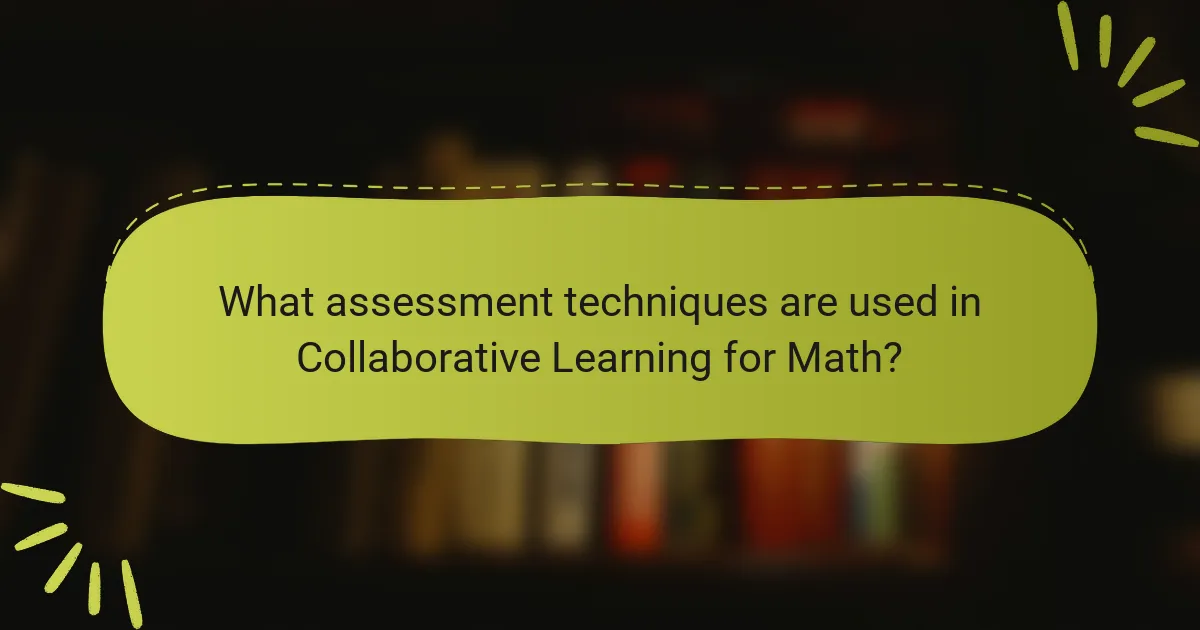
What assessment techniques are used in Collaborative Learning for Math?
Assessment techniques used in Collaborative Learning for Math include peer assessment, formative assessments, and group presentations. Peer assessment allows students to evaluate each other’s contributions, enhancing collaborative skills. Formative assessments provide ongoing feedback during the learning process, facilitating adjustments in teaching strategies. Group presentations encourage students to articulate their understanding and reasoning collectively. Research shows that these techniques improve student engagement and comprehension in mathematics. For example, a study published in the Journal of Educational Psychology found that collaborative assessments significantly enhance learning outcomes.
How can educators assess Collaborative Learning outcomes in math?
Educators can assess Collaborative Learning outcomes in math through various methods. One effective approach is through peer assessment. This allows students to evaluate each other’s contributions and understanding. Educators can also use group projects to measure collaboration. These projects can include specific math problems that require teamwork to solve. Observational assessments during group work provide insights into student interactions. Rubrics can outline expectations for collaboration and individual contributions. Surveys can gather student feedback on their collaborative experiences. Finally, educators may analyze student performance on assessments before and after collaborative activities. This comparison can highlight the impact of collaboration on learning outcomes.
What types of assessments are most effective for measuring collaboration?
Peer assessments are most effective for measuring collaboration. They allow students to evaluate each other’s contributions and teamwork. This method encourages reflection on collaborative processes. Additionally, self-assessments can provide insights into individual perceptions of collaboration. Observational assessments by instructors also effectively gauge collaboration dynamics in group settings. These assessments can reveal interaction patterns and engagement levels. Research shows that combining these assessment types yields comprehensive insights into collaborative skills. For instance, a study by Johnson and Johnson (1999) highlights the benefits of using multiple assessment strategies to evaluate group work.
How can self-assessment and peer assessment be integrated into Collaborative Learning?
Self-assessment and peer assessment can be integrated into Collaborative Learning by incorporating structured reflection and feedback processes. Self-assessment allows students to evaluate their own contributions and understanding. This process encourages metacognition and personal accountability in group settings. Peer assessment involves students evaluating each other’s work, fostering collaboration and critical thinking. Both methods promote a shared responsibility for learning outcomes. Research indicates that these assessments can enhance student engagement and improve learning results. For example, a study by Topping (1998) found that peer assessment significantly increases motivation and performance in collaborative tasks. Integrating these assessments creates a comprehensive approach to evaluating group dynamics and individual learning in Collaborative Learning environments.
What challenges might educators face in assessing Collaborative Learning?
Educators face several challenges in assessing Collaborative Learning. One major challenge is measuring individual contributions within group settings. It can be difficult to determine how much each student has contributed to a group’s outcome. This often leads to issues of accountability. Another challenge is ensuring that assessment criteria are clear and equitable. Ambiguous criteria can result in inconsistent evaluations. Additionally, assessing interpersonal skills and group dynamics adds complexity. Many educators find it hard to quantify these aspects accurately. Time constraints can also hinder effective assessment. Educators may struggle to provide timely feedback on collaborative activities. These challenges highlight the need for clear frameworks and tools for assessment.
How can teachers overcome obstacles in measuring group dynamics?
Teachers can overcome obstacles in measuring group dynamics by implementing structured observation techniques. These techniques involve clearly defined criteria for assessing interactions among students. Teachers can use rubrics to evaluate collaboration, communication, and participation levels. Regular feedback sessions can also provide insights into group dynamics. Additionally, utilizing peer assessments encourages students to reflect on their roles within the group. Research shows that structured assessments enhance understanding of group interactions. A study by Johnson and Johnson (2014) highlights the effectiveness of these methods in improving collaborative learning outcomes.
What strategies can be employed to ensure fair assessment in collaborative settings?
To ensure fair assessment in collaborative settings, clear criteria must be established. These criteria should align with learning objectives and be communicated to all participants. Regular feedback plays a crucial role in this process. It helps students understand their progress and areas for improvement. Peer assessment can also be utilized to provide diverse perspectives on individual contributions. This approach fosters accountability among group members. Additionally, using rubrics can standardize evaluations and minimize bias. Research indicates that structured assessments lead to more equitable outcomes in collaborative learning environments. Implementing these strategies promotes fairness and enhances the overall assessment experience.
What are best practices for implementing Collaborative Learning in Math?
Best practices for implementing Collaborative Learning in Math include forming diverse groups. Diverse groups enhance problem-solving by incorporating various perspectives. Setting clear objectives is essential. Clear objectives guide the learning process and keep students focused. Encouraging active participation is crucial. Active participation fosters engagement and deeper understanding. Providing structured activities helps maintain focus. Structured activities ensure that all students contribute meaningfully. Regular feedback is important. Feedback helps students reflect on their learning and improve. Assessing group work promotes accountability. Accountability encourages students to work together effectively. Research shows that collaborative learning improves math performance and critical thinking skills.
How can educators create effective collaborative groups?
Educators can create effective collaborative groups by establishing clear goals and roles for each member. Clear objectives help students understand their purpose in the group. Assigning specific roles fosters accountability and encourages participation. Additionally, educators should facilitate open communication among group members. This ensures that all voices are heard and valued.
Setting norms for collaboration can guide interactions and promote respect. Providing structured activities can enhance focus and engagement. Regularly assessing group dynamics helps identify any issues early on. Research shows that well-structured collaborative groups improve learning outcomes and student satisfaction.
What tips can enhance the success of Collaborative Learning activities in math?
To enhance the success of Collaborative Learning activities in math, establish clear goals for each session. Clear objectives guide students’ focus and facilitate productive discussions. Encourage diverse group formations to leverage different perspectives and skills. Diverse groups enrich problem-solving approaches and foster creativity. Implement structured roles within groups, such as a facilitator or recorder. Defined roles promote accountability and ensure participation from all members. Use real-world problems to engage students and illustrate mathematical concepts. Real-world applications increase relevance and motivation for learners. Regularly assess group dynamics and provide feedback to improve collaboration. Continuous feedback helps refine group interactions and learning outcomes. Finally, create a supportive environment that values each student’s contribution. A positive atmosphere encourages risk-taking and enhances learning experiences.
Collaborative Learning in Math is an educational approach where students work together to solve mathematical problems, enhancing understanding and problem-solving skills through peer interaction. The article outlines the definition, key characteristics, and significance of this method, emphasizing its benefits such as improved academic performance and critical thinking. It also explores various methods for implementing Collaborative Learning, including group work and peer teaching, while discussing assessment techniques like peer and self-assessment. Additionally, the article highlights challenges educators may face in assessing collaboration and offers best practices for creating effective collaborative groups.
